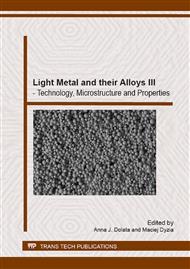p.23
p.31
p.39
p.47
p.53
p.57
p.65
p.71
p.77
Fine Particle Reinforced Composites Obtained by Suspension Method
Abstract:
In the production of composites by the suspension method (mechanical stirring) may beused, ceramic particles, which are wetted by the liquid metal such SiC, Al2O3 or glassy carbon.However, to obtain a stable suspension with the use a particle size below 10 μm is extremelydifficult. Phenomena related i.a. with agglomeration of particles, convection currents over moltenmetal surface make practically impossible to obtain composite material. One possibility to obtainfine reinforced composite is the use of in situ methods, in which the reinforcing phase is formed bythe reaction between the aluminum and the reactive powder oxides such FeO, TiO2, SiO2, NiO, Nb2O5 or Fe2O3. Such reactions are exothermic (aluminothermic) and their kinetics dependent onthe dispersion of the reactants, the quantitative phase composition and temperature.The technological solution involving the formation of a suspension with particles (chemically activewith aluminum) is one of the promising solutions to obtain batch material for the synthesis ofcomposites reinforced with Al2O3 and intermetallic phases. The aim of this study is to evaluate thesuitability of suspension technology to obtained in situ fine reinforced composite.
Info:
Periodical:
Pages:
53-56
Citation:
Online since:
November 2013
Authors:
Price:
Сopyright:
© 2014 Trans Tech Publications Ltd. All Rights Reserved
Share:
Citation:


